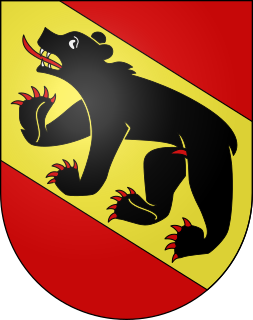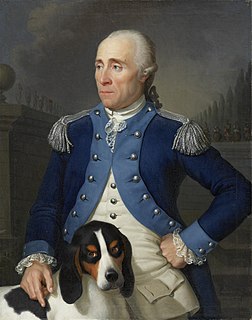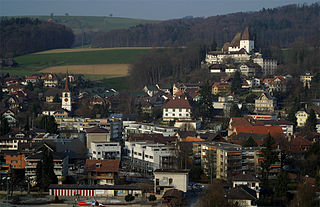
Bern or Berne is the de facto capital of Switzerland, referred to by the Swiss as their Bundesstadt, or "federal city". With a population of 142,493, Bern is the fifth-most populous city in Switzerland. The Bern agglomeration, which includes 36 municipalities, had a population of 406,900 in 2014. The metropolitan area had a population of 660,000 in 2000. Bern is also the capital of the canton of Bern, the second-most populous of Switzerland's cantons.
Johann David Wyss was a Swiss author, best remembered for his book The Swiss Family Robinson (1812). It is said that he was inspired by Daniel Defoe's Robinson Crusoe, but wanted to write a story from which his own children would learn, as the father in the story taught important lessons to his children. The Swiss Family Robinson was first published in German in 1812 and translated into English two years later. It has since become one of the most popular books of all time. The book was edited by his son, Johann Rudolf Wyss, a scholar who wrote the Swiss national anthem. Another son, Johann Emmanuel Wyss, illustrated the book. Unlike his son Johann Rudolf, who died at the age of 48, Johann David Wyss lived up to the age of 74, dying in 1818.

Spiez is a town and municipality on the shore of Lake Thun in the Bernese Oberland region of the Swiss canton of Bern. It is part of the Frutigen-Niedersimmental administrative district. Besides the town of Spiez, the municipality also includes the settlements of Einigen, Hondrich, Faulensee, and Spiezwiler.
Landammann, is the German title used by the chief magistrate in certain Cantons of Switzerland and at times featured in the Head of state's style at the confederal level.

The Üechtland is a region in western Switzerland, where the cities of Bern and Fribourg are located.

Adrian von Bubenberg was a Bernese knight, military commander and mayor (Schultheiss) of Bern in 1468-1469, 1473-1474 and 1477-1479. In Switzerland, he is remembered as the hero of the Battle of Murten.

The coat of arms of Bern, along with the associated flag and heraldic colours, are used both by the Swiss city of Bern and by the canton of the same name. They were also used by the former district of Bern until its abolition in 2009.

Prince Adrian Vinzenz Eduard of Saxe-Coburg and Gotha was the fourth child and second son of Friedrich Josias, Prince of Saxe-Coburg and Gotha.

The Bärengraben, or Bear Pit, is a tourist attraction in the Swiss capital city of Bern. It is a bear pit, or enclosure housing bears, situated at the eastern edge of the old city of Bern, next to the Nydeggbrücke and the River Aar. Although still in use, the Bärengraben has been supplemented since 2009 by the adjacent BärenPark, a larger and more natural enclosure alongside the River Aar.

The Junkerngasse is a street in the Old City of Bern, the medieval city center of Bern, Switzerland. It connects the tip of the Aar peninsula to the Münster.

Toffen Castle is a Baroque country estate in Toffen, Canton of Bern, Switzerland. It is a Swiss heritage site of national significance.

Gottstat Monastery is a former Premonstratensian monastery in the Orpund community in Canton of Bern, Switzerland.

The Bubenbergplatz is a plaza in the Old City of Bern, the medieval city center of Bern, Switzerland. It is part of the area outside the third city walls. It is located south-west of Bahnhofplatz and is part of the UNESCO Cultural World Heritage Site that encompasses the Old City.

Franz Rudolf Frisching (1733–1807) was a Bernese patrician, officer, politician and industrialist.

The Erlacherhof is a town mansion on the Junkerngasse No. 47 in the Old City of Bern, Switzerland, only a few steps away from the Béatrice-von-Wattenwyl-Haus.

Jegenstorf Castle is a castle in the municipality of Jegenstorf of the Canton of Bern in Switzerland. It is a Swiss heritage site of national significance.

Spiez Castle is a castle in the municipality of Spiez of the Swiss canton of Bern. It is a Swiss heritage site of national significance.
In legend and in the early historiography of Switzerland there is an account of a migration of a population of Swedes and Frisians settling in the Swiss Alps, specifically in Schwyz and in Hasli (Schwedensage).

Ittigen Castle is a historical country house in Ittigen in the Canton of Bern in Switzerland.
Johannes Fründ was a Swiss clerk and chronicler.



















